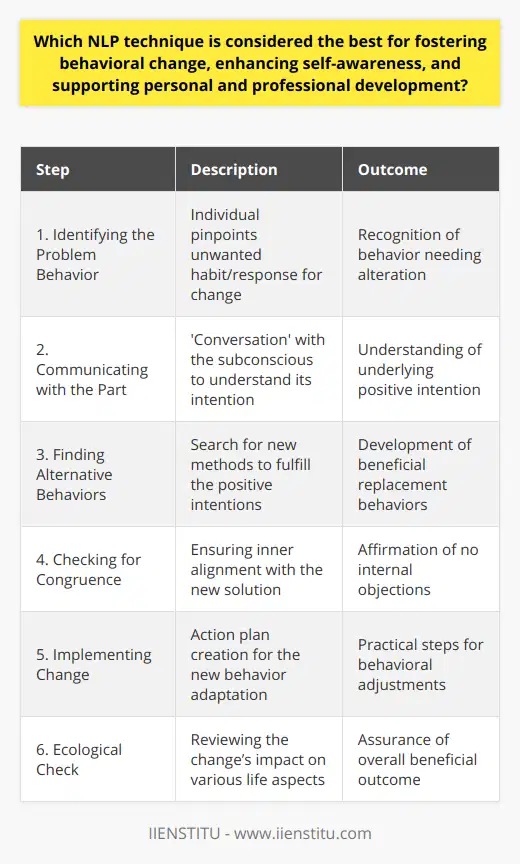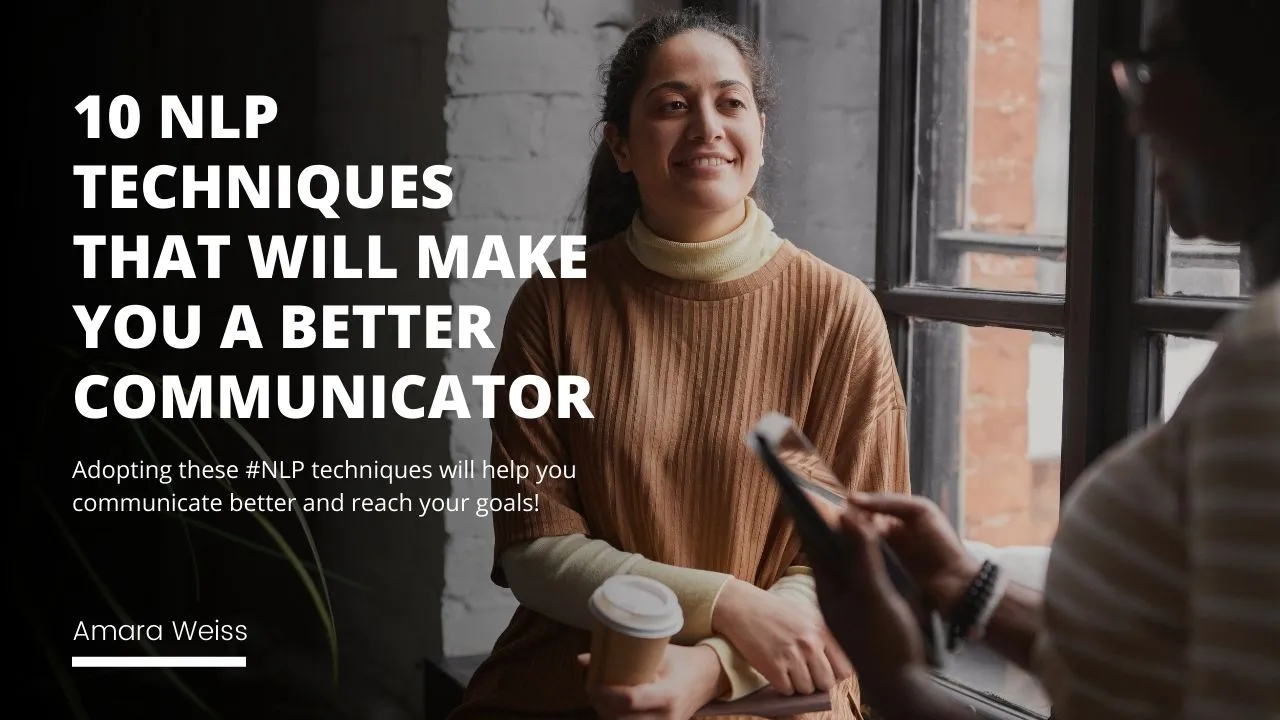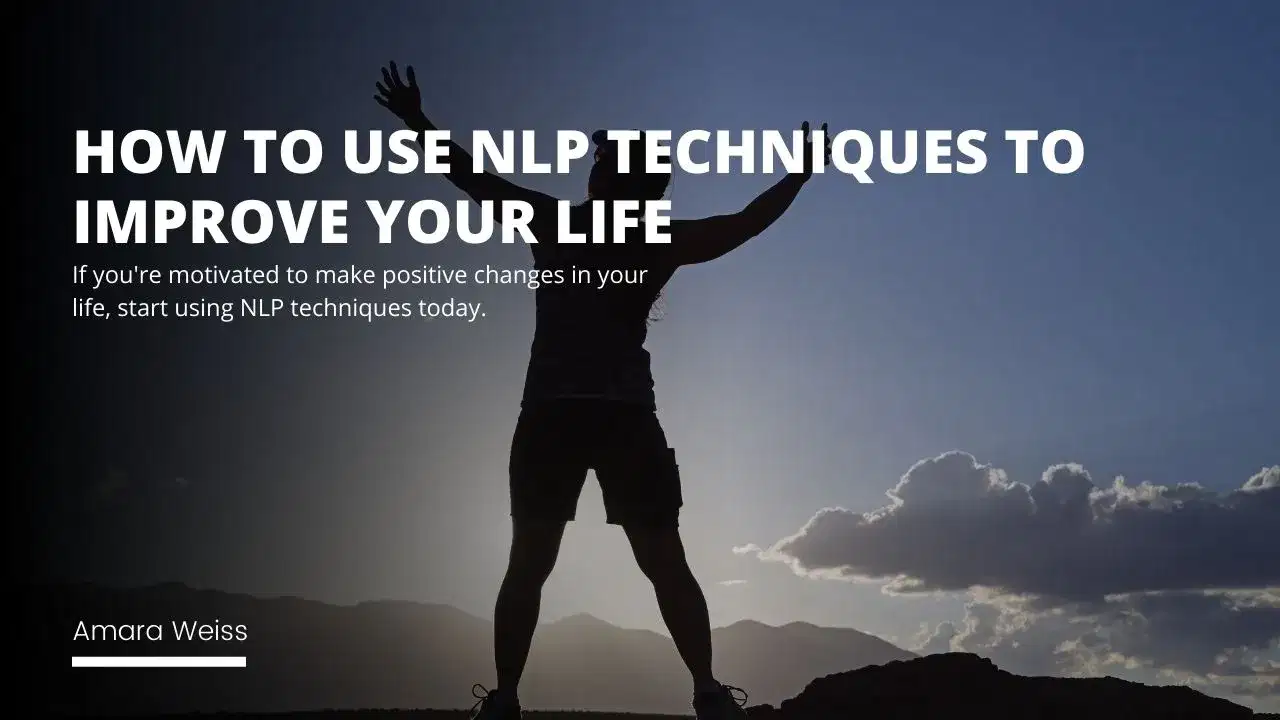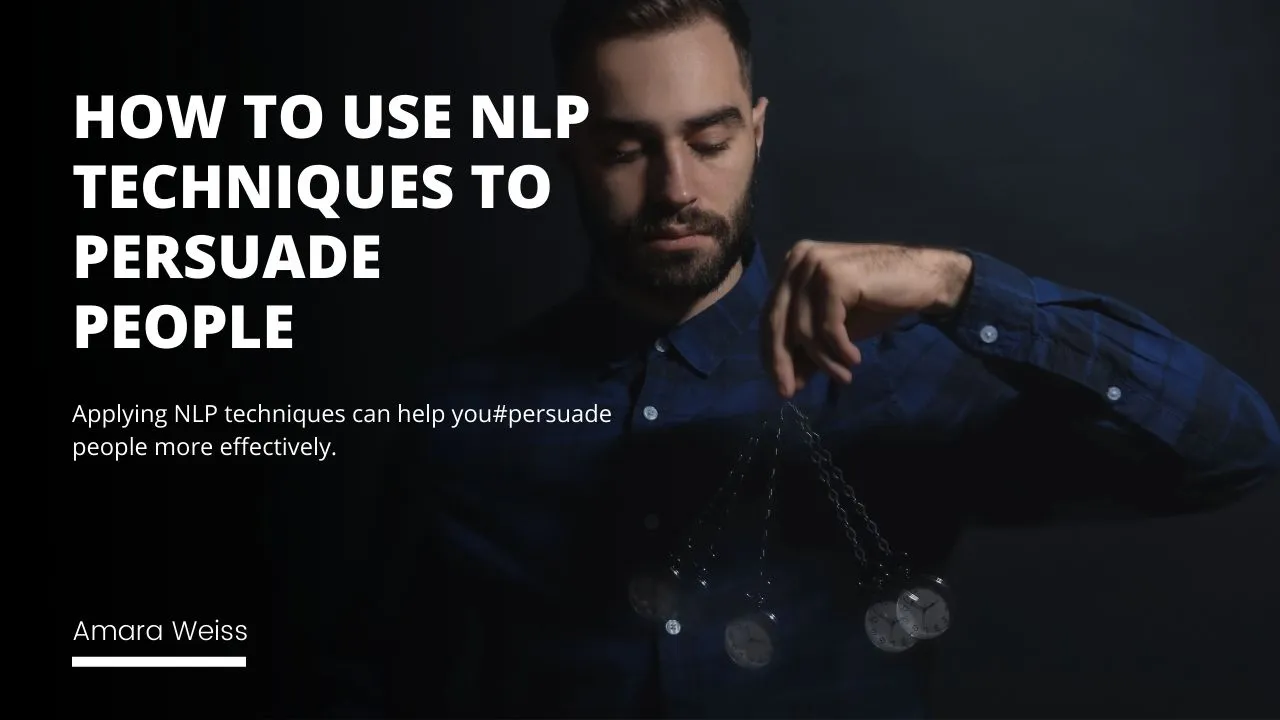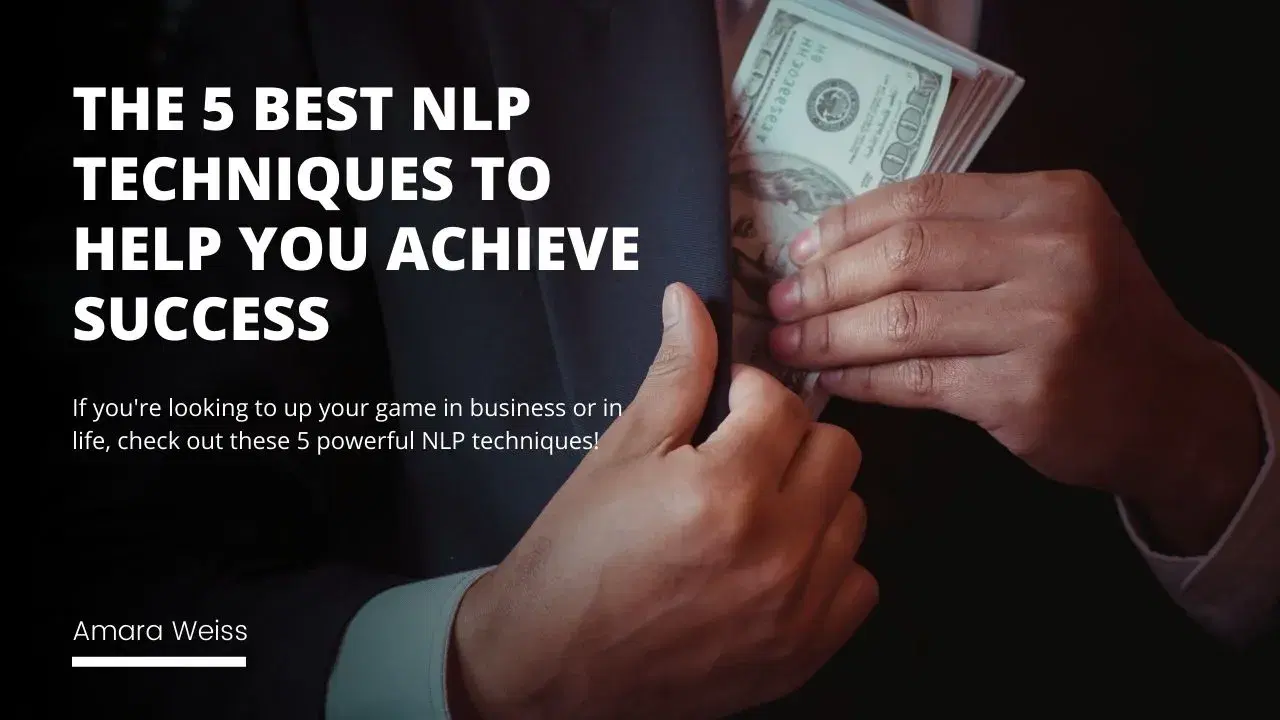
Neuro-linguistic programming, or NLP, is a powerful toolset that can help you achieve success in all areas of your life. Here are five of the best NLP techniques to get you started.
NLP can help you achieve greater clarity of thought, better communication skills, and increased confidence. It's a set of techniques that can help you change your thinking and behavior for the better, leading to a more prosperous and fulfilling life. So why not give NLP a try? You may be surprised at just how effective it can be!
Learn the 5 best NLP techniques to help you achieve success.
Most people are familiar with the basic principles of NLP, or Neuro-Linguistic Programming. However, few realize that these same techniques can be used in everyday life to help achieve success. Here are five of the best NLP techniques to help you get ahead in life:
Anchoring
Anchoring is a technique that can help you achieve your goals. It involves linking a desired state or outcome to a physical sensation so that when you feel the sense, it triggers the desired shape. For example, if you want to feel more confident, you could anchor the feeling of confidence to the sensation of standing up straight with your shoulders back. Then, you'll automatically feel more confident whenever you stand in that position.
What is anchoring, and how does it work
Anchoring is a cognitive bias that describes the human tendency to rely too heavily on the first piece of information offered (the "anchor") when making decisions. Even if the original data is entirely irrelevant to the decision at hand, our brains tend to hold on to that initial anchor, which can distort our judgment and lead us to make suboptimal choices.
While anchoring may seem like a relatively innocuous quirk of human cognition, it can significantly impact our everyday lives. For example, research has shown that anchoring can influence everything, from how much we're willing to pay for an item to judging the severity of a crime. In one study, participants were shown sentences describing various crimes and asked to estimate the prison sentence the offender should receive.
The sentences differed only in the number of years that were anchor sentences (e.g., "The defendant should serve eight years in prison" vs. "The defendant should serve 25 years in prison"). Not surprisingly, the participants who saw the higher number of anchors estimated much harsher sentences, on average, than those who saw the lower number of anchors.
While anchoring is a powerful influence on our decision-making, it's important to remember that we can fight back against this bias by being aware of it and making a conscious effort to override it. So the next time you find yourself about to decide, take a step back and ask yourself if you're relying too heavily on the first piece of information you heard.
Examples of how anchoring has been used to influence people's actions
For example, everyday life is full of anchoring opportunities. Stores use anchoring to influence what people are willing to pay for items. They do this by putting the thing on sale at a high price and then offering a discount. The high initial price serves as the anchor, and the value makes the final price seem like a bargain.
This same technique can also be used in negotiation situations. If one person offers a high starting price, it can influence the other person's final offer. Anchoring can also be used in social cases. For example, if someone compliments you, it can affect how you see yourself. The next time someone pays you a compliment, take a step back and ask yourself if you're letting it unfairly control your opinion of yourself.
The takeaway
Anchoring is a cognitive bias that describes the human tendency to rely too heavily on the first piece of information offered when making decisions. Even if the original data is entirely irrelevant to the decision at hand, our brains tend to hold on to that initial anchor, which can distort our judgment and lead us to make suboptimal choices.
Swish Pattern
The swish pattern is a powerful NLP technique that can change unwanted behaviors or thoughts. It replaces undesired thinking or conducts with a more desirable one. For example, if you tend to procrastinate, you could use the swish pattern to replace the thought of procrastinating with the idea of taking action.
What is Swish Pattern NLP, and how can it benefit me as a business owner or individual
As business owners or individuals, Swish Pattern NLP can benefit us. For example, it can help us overcome procrastination, break bad habits, boost our confidence and self-belief, and increase our motivation levels. It can also allow us to improve our communication skills, both regarding what we say and how we say it. Essential Swish Pattern NLP can help us achieve success in any area of our lives.
How does Swish Pattern NLP work?
Swish Pattern NLP works by replacing an undesired thought or behavior with a more desirable one. It does this by utilizing the power of visualization and positive affirmations. First, you need to identify the undesired behavior or thought you want to change. Once you have done this, you need to develop a replacement behavior or thought that is more desirable.
For example, if you're going to stop procrastinating, your replacement behavior could be taking action. Once you have identified the replacement behavior or thought, you need to create a mental image of yourself carrying out that behavior or thinking. This image should be as vivid and detailed as possible. Finally, it would help to repeat your positive affirmation (e.g., "I am an action taker") several times until you believe it to be true.
What are the benefits of using Swish Pattern NLP?
There are many benefits to using Swish Pattern NLP. As well as helping us to overcome procrastination, break bad habits, boost our confidence and self-belief, and increase our motivation levels. It can also allow us to improve our communication skills, both regarding what we say and how we say it. Swish Pattern NLP can help us achieve success in any area of our lives.
How do I use Swish Pattern NLP?
If you want to start using Swish Pattern NLP, the first step is to identify the undesired behavior or thought you want to change. Once you have done this, you need to develop a replacement behavior or thought that is more desirable. For example, if you're going to stop procrastinating, your replacement behavior could be taking action.
Once you have identified the replacement behavior or thought, you need to create a mental image of yourself carrying out that behavior or thinking. This image should be as vivid and detailed as possible. Finally, it would help to repeat your positive affirmation (e.g., "I am an action taker") several times until you believe it to be true.
The Swish Pattern is a powerful NLP technique that can change unwanted behaviors or thoughts. It replaces undesired thinking or conducts with a more desirable one. For example, if you tend to procrastinate, you could use the swish pattern to replace the thought of procrastinating with the idea of taking action.
Visualization
Visualization is a technique that can be used to achieve any goal. It involves picturing yourself achieving your goal in your mind as vividly as possible. The more realistic and detailed your visualization, the more likely you will achieve your goal. So, if you want to lose weight, for example, you could visualize yourself looking and feeling slimmer and being able to fit into your favorite clothes.
The power of positive visualization
Most of us go through everyday life on autopilot, not paying attention to what we're doing or where we're going. But what if we took a moment to visualize our perfect day? What would it look like? How would we feel?
When we take the time to imagine our ideal scenario, we open up the possibility of making it a reality. Our brain doesn't know the difference between what's real and imaginary, so when we picture ourselves achieving our goals, we start to believe it's possible. And when we think something is possible, we're more likely to take action towards making it happen.
What is visualization, and how can it be used to achieve success in business and life overall
Visualization is the process of creating a mental image of something. We do it all the time; everyday life is full of visualizations. For example, when you visualize your dream house or picture yourself winning the lottery.
In business, visualization can be used to help you achieve success. For example, if you want to get a promotion, visualize yourself in the role you want and what it would feel like. By picturing yourself achieving your goal, you are more likely to take the necessary steps to make it happen.
Visualization can also be used to achieve success in life overall. For example, if you want to be happier and healthier, picture yourself healthy and surrounded by people who make you.
Pacing and Leading
Pacing and leading are techniques that can be used to influence other people. It involves mirroring the other person's body language, voice tone, and words (pacing) before gradually moving ahead of them (leading). For example, if you want to persuade someone to agree with you, you could start by matching their body language and voice tone, then slowly begin to move ahead, using more confident body language and a stronger voice.
What are the benefits of pacing and leading in business or personal interactions?
Pacing and leading is a technique that can be used in everyday life, whether interacting with others for business or personal purposes. First, the basic idea is to match the other person's energy level or pace and gradually increase your energy until you're leading the interaction. This can be helpful in a variety of situations.
For example, if you're meeting with a potential client who seems nervous, you can pacify them by speaking slowly and deliberately. Then, once they start to feel more comfortable, you can pick up the pace and introduce new ideas. Or, if you're trying to persuade someone to make a change in their behavior, starting by matching their energy level can help create a rapport before you attempt to lead them in.
Can you think of any situations where pacing and leading would not be practical or desirable?
Pacing and leading is a technique often used in sales and negotiation, but it can also be helpful in everyday life. The basic idea is to match the other person's behavior to build rapport and lead them in the direction you want them to go. However, there are some situations where this technique would not be practical or desirable.
For example, if you are dealing with someone who is very emotional, pacing them may only serve to intensify their emotions. In addition, if you are trying to resolve a conflict, pacing and leading could make the situation worse by escalating the tension. Finally, some people do not like to be led, and for these people pacing and leading would likely be ineffective. Overall, it is essential to use pacing and show to be respectful and consider the other person.
Reframing
Reframing is a technique that can change the way you see a situation. It involves changing your interpretation of a situation so that it has a positive effect on you. For example, if you've just been rejected for a job, you could reframe the situation by telling yourself that it wasn't the right job for you anyway and that this rejection has saved you from being unhappy in a job that wasn't suited to you.
What is reframing, and how can it be used to improve your life
We are constantly faced with choices in our everyday lives. Some of these choices are more significant than others, but all of them have the potential to impact our lives in one way or another. The ability to reframe these choices is a powerful tool that can help us to improve our lives.
Reframing is the process of looking at a situation from a different perspective. This can be done in two ways: changing the way we think about the problem or changing the case itself. When reframing a position, we open ourselves up to new possibilities and solutions. We may also find that what seemed like a problem before is not as big a deal as we thought.
There are
Some benefits of reframing include:
Finding new solutions to problems
Reducing stress
Improving our mood
Helping us to see the positive side of a situation
Encouraging us to take action
Reframing is a technique that can be used in any area of life, from our relationships to our careers. It is a valuable tool that can help us to improve our lives and make better choices.
Tips for using reframing in your daily life
Here are some tips for using reframing in your everyday life:
When something negative happens, try to look for the silver lining. For example, if you get cut off in traffic, try to see it as an opportunity to practice patience instead of getting angry.
When you find yourself dwelling on negative thoughts, try to reframe them in a more positive light. For example, instead of thinking, "I'm so fat," try thinking, "I am working on improving my health."
If you face a difficult decision, try to look at it from different angles. For example, if you consider whether or not to quit your job, instead of looking at it as giving up, try to see it as an opportunity for new beginnings.
Whenever you catch yourself making assumptions about someone or something, try to challenge those assumptions. For example, if you judge someone based on their appearance, try to remember that you don't know anything about them and that everyone is fighting their own battles.
These are just five of the many NLP techniques that can help you succeed. So why not try using them in your own life and see how they can help you achieve your goals?
That's all for now on the five cognitive biases. If you want to learn more about how to use these techniques in your business, join our upcoming NLP course.
In this course, we will be going into more depth on each of these principles and show you how to apply them to sales conversations, negotiations, and presentations. Keep an open mind and start using these tricks to give yourself an edge in business!

Frequently Asked Questions
What are the key components of NLP techniques and how do they contribute to achieving success in various domains?
Key Components of NLP Techniques
Understanding Natural Language Processing (NLP) techniques' key components helps explain their successful implementation across various domains. NLP is an interdisciplinary field, incorporating computer science, linguistics, and artificial intelligence (AI) to facilitate human-computer interaction through natural language.
Tokenization and Parsing
Tokenization is an essential aspect of NLP, which involves breaking down text into individual words or tokens. This step simplifies text analysis, enabling further processing of the input data. Parsing follows tokenization, segmenting sentences into their constituent parts; this process helps machines understand the grammatical relationships between words and improves language comprehension.
Part-of-Speech Tagging
Part-of-speech (POS) tagging is another critical component, assigning grammatical categories (such as nouns, verbs, adjectives) to tokens. POS tagging enhances NLP applications' accuracy by helping computers comprehend the syntactic structure of a sentence, thereby improving their analysis.
Named Entity Recognition
Named entity recognition (NER) is an NLP technique that identifies and categorizes real-world objects, such as people and organizations, within a given text. NER contributes to information extraction in tasks like summarization and sentiment analysis, benefiting various domains such as finance, healthcare, and customer service.
Machine Learning and Deep Learning
Machine learning (ML) and deep learning (DL) are integral to NLP techniques, enabling computers to learn automatically and improve their language models. ML and DL facilitate the development of advanced algorithms that can handle large volumes of data, ensuring high-performance NLP applications across diverse fields.
NLP Applications in Various Domains
NLP techniques' key components allow for the successful deployment of applications such as sentiment analysis, machine translation, and text summarization. In business, sentiment analysis can enable organizations to gauge customer feedback and detect market trends, leading to informed decision-making. Machine translation helps bridge the communication gap across language barriers, enhancing global collaboration. Text summarization tools can assist researchers in extracting relevant information from vast volumes of text, expediting knowledge discovery and innovation.
In conclusion, the key components of NLP techniques, such as tokenization, parsing, POS tagging, named entity recognition, and the integration of ML and DL, contribute significantly to the success of NLP applications across numerous domains. By harnessing these components, NLP techniques facilitate effective human-computer interaction through natural language, enabling advancements in various fields and industries.

How can individuals utilize the five NLP tactics for negotiations to reach mutually beneficial agreements?
Utilizing NLP Tactics for Effective Negotiations
Establish Rapport
The first NLP tactic is to establish rapport, which is crucial in negotiations as it helps build trust and understanding between the parties involved. Individuals can achieve this by adopting a similar body language, tone of voice, and conversational patterns with the other party, enabling them to create a comfortable atmosphere and promote open communication.
Understand the Other Party's Perspective
To reach mutually beneficial agreements, incorporating empathy and understanding of the other party's perspective is vital. Using NLP techniques such as the Meta Model, individuals can ask insightful questions to identify the underlying beliefs, values, and concerns driving the other party's demands. By demonstrating genuine interest and understanding, negotiators are more likely to achieve collaborative outcomes.
Set Clear and Prioritized Outcomes
Achieving a mutually beneficial agreement requires participants to have clear and prioritized outcomes. Utilizing the NLP Well-Formed Outcome technique, negotiators can create specific, measurable, achievable, realistic, and time-bound objectives. These well-defined goals enable individuals to focus on finding common ground and identifying areas of compromise with the other party.
Utilize Anchoring and Reframing Techniques
Anchoring and reframing are NLP techniques that enable negotiators to influence the other party's emotional state by anchoring positive emotions to desired outcomes, and reframing negative experiences as opportunities. By associating positive emotions with shared goals, individuals can increase the likelihood of achieving a mutually beneficial agreement. Additionally, reframing provides negotiators with the ability to shift the other party's perspective, potentially overcoming objections or challenges.
Use the Pacing and Leading Method
Finally, the pacing and leading method involves matching the other party's behavior (pacing) to gain rapport and trust, and then gradually introducing new behaviors or ideas (leading) to influence their actions. In the context of negotiations, individuals can utilize this tactic to subtly guide the other party toward mutually beneficial solutions, ensuring that both sides feel satisfied with the final agreement.
In conclusion, employing the five NLP tactics for negotiations allows individuals to build trust, understand various perspectives, set clear outcomes, influence emotions and perspectives, and subtly guide the negotiation process. Implementing these techniques, negotiators can significantly enhance their ability to reach mutually beneficial agreements.
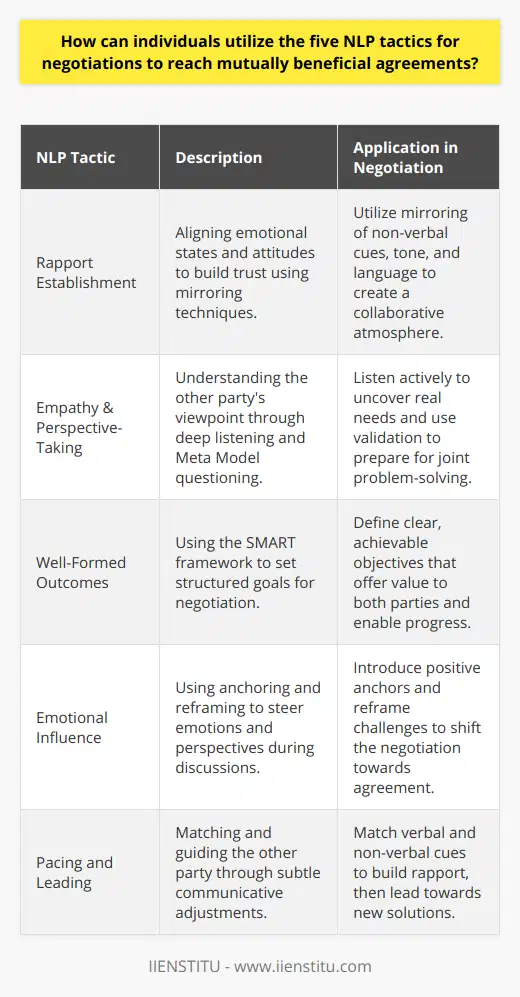
In what ways can the five NLP insights for successful meetings enhance communication and decision-making processes within a group?
NLP Insights for Effective Group Communication
The five NLP insights for successful meetings have the potential to significantly improve communication and decision-making processes within a group. These insights, when appropriately applied, can enhance the group's overall performance and foster a more productive work environment.
Establishing Rapport
Firstly, by establishing rapport among group members, NLP insights help create an atmosphere of trust and mutual understanding. In this environment, individuals are more open to sharing their ideas, listening to others, and working together effectively. Consequently, this enhances both communication and decision-making processes within the group.
Setting Clear Goals
Secondly, NLP insights emphasize the importance of setting clear and attainable goals. Clearly defined objectives allow group members to focus their efforts, streamline the decision-making process, and ensure that everyone works together toward a common aim. This approach also helps in reducing misunderstandings, resulting in more effective communication.
Maintaining Flexibility
Thirdly, the NLP approach highlights the significance of flexibility within meetings. By embracing flexibility, group members can adapt to new ideas or circumstances, enabling a smoother decision-making process. This flexibility encourages open communication and exchange of ideas, promoting creativity and innovation within the group.
Providing Constructive Feedback
Fourthly, NLP insights stress the importance of giving and receiving constructive feedback. This feedback approach enables members to identify potential areas of improvement, refine their ideas, and make better-informed decisions. Moreover, constructive criticism helps to facilitate honest and open communication, leading to stronger group dynamics.
Acknowledging Individual Contributions
Lastly, recognizing the contributions of individual members bolsters a sense of accomplishment and value within the group. This acknowledgement establishes an environment where members feel inspired, motivated, and more likely to communicate their ideas constructively. Ultimately, this strengthens the group's decision-making capabilities and ties together the overall benefits of NLP insights in improving group performance.
In conclusion, the five NLP insights for successful meetings serve as valuable tools to foster effective communication and decision-making processes within group settings. By implementing these valuable techniques, groups can achieve optimal performance and unlock their full potential.
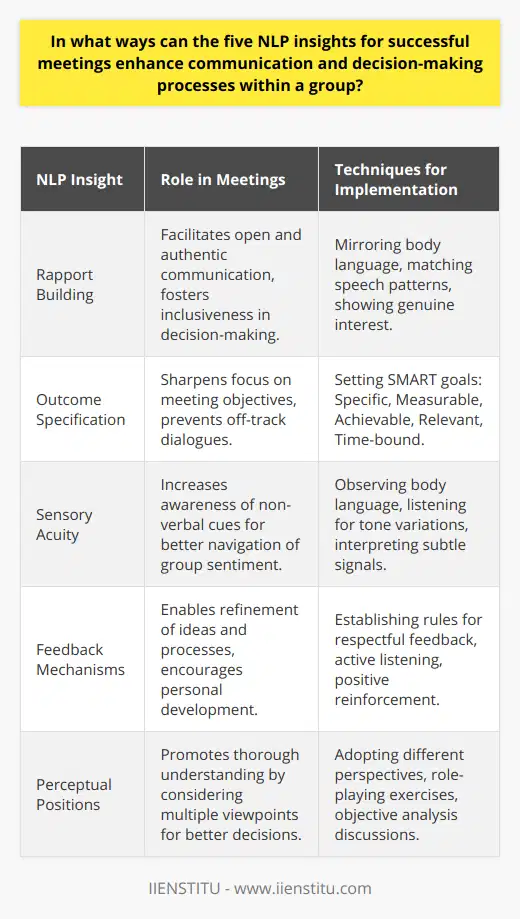
What are the 5 NLP concepts that support coaching and how do they influence personal and professional growth?
NLP Concepts in Coaching
**1. Rapport Building**
One of the fundamental concepts of neuro-linguistic programming (NLP) in coaching is rapport building, which helps establish trust and connection between the coach and client. By mirroring and matching the client's verbal and non-verbal cues, the coach can facilitate open communication and elicit valuable insights, enabling more effective goal-setting and problem-solving.
**2. Sensory Acuity**
Sensory acuity is crucial in NLP coaching as it allows the coach to observe subtle changes in the client's behavior and physiology. This heightened awareness enables the coach to adapt their approach accordingly and address underlying issues, positively impacting both personal and professional growth.
**3. Outcome Orientation**
Focusing on desired outcomes is a core aspect of NLP coaching. Instead of dwelling on past failures or problems, the coach helps the client to envision their future success and formulate specific, achievable goals. This forward-thinking approach aids in fostering a proactive mindset and encourages continuous development in various aspects of life.
**4. Meta-Modeling**
The meta-model is a linguistic tool used in NLP coaching to challenge limiting beliefs and uncover deeper meaning behind a client’s language patterns. By asking precise questions and identifying vague or distorted information, the coach assists the client in clarifying their thoughts and creating new possibilities for growth and transformation.
**5. Anchoring Techniques**
Anchoring is an NLP technique that involves associating a specific stimulus with a desired emotional or behavioral response. In coaching, this concept aids clients in creating and maintaining resourceful states, such as confidence, motivation, or relaxation. By mastering anchoring techniques, clients can tap into these positive states when needed, significantly contributing to their personal and professional advancements.
In conclusion, the five NLP concepts discussed play a pivotal role in the coaching process, enhancing communication, fostering goal-oriented thinking, challenging limiting beliefs, and promoting the development of resourceful states. By incorporating these principles, coaching can effectively support clients in achieving significant personal and professional growth.
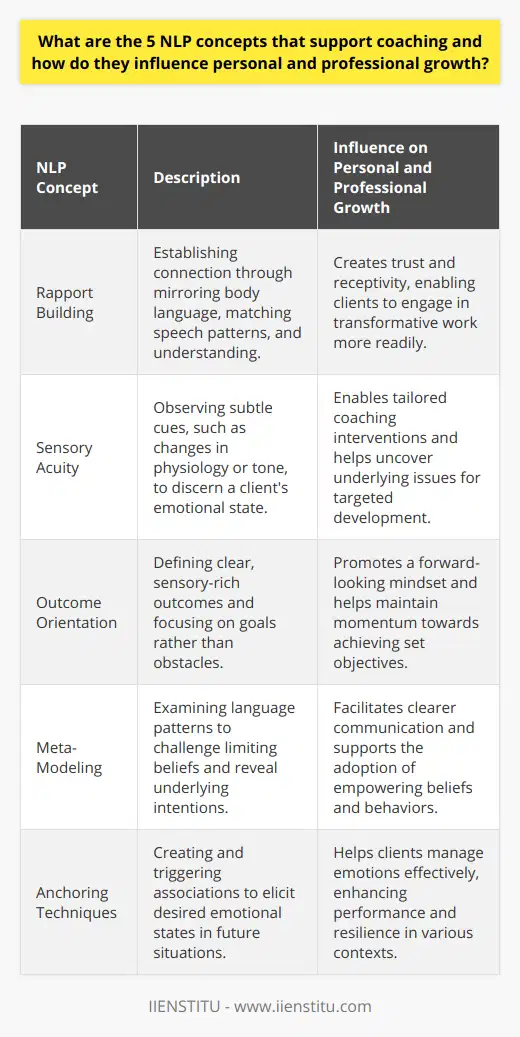
How do you use NLP techniques to overcome limiting beliefs and foster success in various aspects of life?
**NLP Techniques and Limiting Beliefs**
Neuro-Linguistic Programming (NLP) techniques play a critical role in overcoming limiting beliefs that hinder personal growth and achievement. By identifying and reprogramming these self-defeating thought patterns, individuals can effectively replace them with empowering beliefs that foster success in various aspects of life.
**Identifying Limiting Beliefs**
The first step in utilizing NLP involves identifying one's limiting beliefs by examining personal thought patterns and responses to challenging situations. This self-analysis promotes greater self-awareness and reveals the frequently hidden issues that need addressing.
**Anchoring Positive States**
To counteract limiting beliefs, NLP employs anchoring as a powerful technique to create and access resourceful emotional states. By associating a specific gesture, touch, or word with a positive emotion, individuals can intentionally evoke this state when encountering obstacles, empowering them to overcome mental barriers.
**Reframing Perspectives**
Another essential NLP technique involves reframing, the process of changing one's perspective on a situation to perceive it in a more empowering light. This cognitive shift enables individuals to reinterpret the meaning of past events, leading to more positive and constructive responses to future challenges.
**Creating Empowering Affirmations**
NLP harnesses the power of language to impact our beliefs and emotions through empowering affirmations. By crafting personalized, positive statements that resonate with personal goals, individuals can embed new beliefs into their thought processes, replacing adverse thought patterns with a more success-oriented mindset.
**Modelling Success**
Modelling, an NLP practice whereby individuals observe and imitate successful people's behaviors and thought processes, can also contribute to overcoming limiting beliefs. By adopting effective strategies from accomplished individuals relevant to one’s ambitions, personal growth becomes attainable and rapid.
**Visualizing and Goal Setting**
Visualization strengthens an individual's ability to achieve success by vividly picturing desired outcomes, fostering motivation and resilience. Coupled with clear goal setting, this NLP technique enables individuals to maintain a focused and actionable blueprint for overcoming limiting beliefs and achieving their objectives.
In conclusion, NLP techniques facilitate the dismantling of limiting beliefs, empowering individuals to break free from self-imposed restrictions and reach their full potential. By incorporating NLP methods into daily practices, individuals can foster personal development and achieve success in various aspects of life.
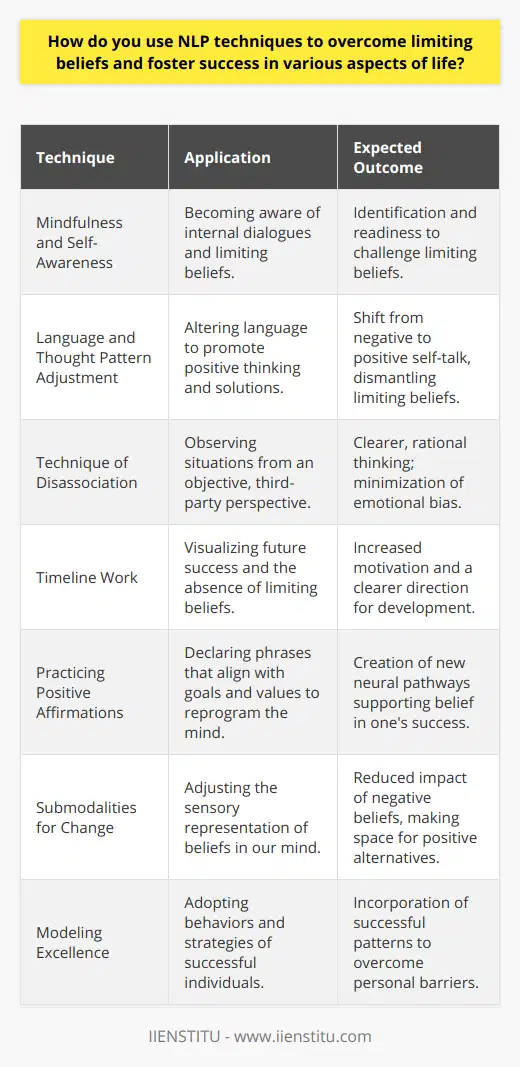
In what ways can NLP techniques aid in enhancing communication, rapport-building, and problem-solving in organizational and interpersonal settings?
NLP Techniques in Enhancing Communication
Natural Language Processing (NLP) techniques can significantly improve communication by facilitating understanding and interpretation of human language. Through advanced algorithms and machine learning models, NLP enables computers to analyze and comprehend textual data, thus enabling clear and effective communication. This has the potential to greatly enhance rapport-building and problem-solving in organizational and interpersonal settings.
Boosting Rapport-building
One way NLP aids in rapport-building is by assisting users in developing empathy and understanding the perspectives of others. Sentiment analysis, a core aspect of NLP, helps in identifying the emotions and underlying tone of a conversation. By analyzing the specific words and phrases being used, individuals can gain insights into the emotions and intentions of their interlocutors, leading to more effective communication and stronger connections.
Facilitating Effective Problem-solving
NLP techniques support problem-solving by enabling users to analyze and interpret textual data with greater ease. For instance, NLP-powered text summarization tools help individuals identify key points and concepts in large documents or discussions, which leads to more informed decision-making. Additionally, NLP-driven chatbots can process and understand user queries and provide relevant information on-demand, improving problem-solving capabilities in organizational settings.
Improving Interpersonal Communication
Another benefit of NLP techniques in enhancing communication is their ability to overcome language barriers. NLP-powered translation tools can enable individuals to communicate seamlessly with people from different linguistic and cultural backgrounds. Moreover, NLP-driven speech recognition technologies empower users with disabilities to access information and communicate effectively, thus promoting inclusivity and reducing the communication gap.
Supporting Collaboration and Teamwork
Finally, NLP techniques can also foster collaboration and teamwork by streamlining the flow of information and enhancing the understanding of individual roles and responsibilities. Through the use of NLP algorithms, team members can quickly analyze and interpret the vast array of communication data exchanged during project discussions. This facilitates a better understanding of individual perspectives and promotes efficient collaboration and decision-making.
In conclusion, the role of NLP techniques in improving communication, rapport-building, and problem-solving is invaluable. By leveraging advanced algorithms, NLP enables individuals and organizations to communicate more effectively, comprehend complex textual data, and overcome language barriers. As a result, NLP techniques have the potential to substantially enhance communication and problem-solving abilities in both organizational and interpersonal settings.
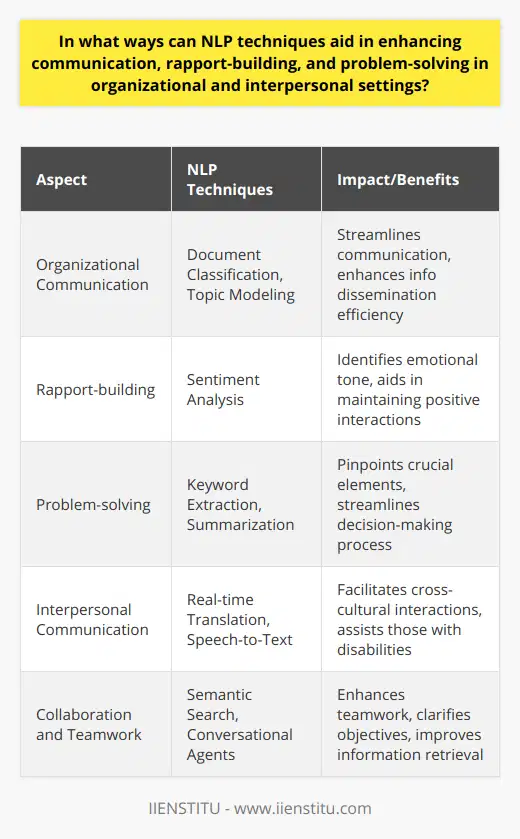
What are the essential NLP techniques that can be employed to facilitate success in personal and professional settings?
Essential NLP Techniques for Success
Effective Communication Skills:
One of the fundamental NLP techniques is honing effective communication skills, which are vital in both personal and professional settings. By improving verbal and non-verbal communication, individuals can create better connections with others and increase their chances of success.
Rapport Building:
Establishing rapport and creating strong bonds with others is an essential NLP technique that fosters trust and mutual understanding. This process involves leveraging body language, tone, and other forms of communication to connect with colleagues, friends, or clients on a deeper level.
Goal Setting and Prioritization:
Utilizing NLP techniques for goal setting and prioritization helps individuals and organizations define and achieve their objectives. By establishing clear targets and breaking them down into manageable tasks, individuals can increase focus, motivation, and long-term success.
Anchoring Techniques:
NLP anchoring techniques involve creating mental associations with positive states or experiences. By using these cognitive links, individuals can quickly retrieve empowering emotions, enhancing performance in personal and professional situations.
Reframing Perspectives:
Altering one's mindset is a crucial NLP technique that transforms negative thought patterns into constructive thinking habits. Reframing perspectives can boost self-confidence, fuel motivation, and enhance problem-solving abilities in various contexts.
Modeling Excellence:
A crucial NLP technique for success is modeling excellence, which involves observing and imitating the successful habits of high performers. This practice enables individuals to adopt productive behaviors, refining skills, and improving performance in their personal and professional lives.
Eliminating Limiting Beliefs:
Using techniques to identify and eliminate limiting beliefs helps individuals overcome personal barriers and unlock their potential. Freeing oneself from self-imposed constraints fosters growth and supports success in various life domains.
In conclusion, incorporating NLP techniques into personal and professional settings can significantly enhance individual success. Improving communication skills, building rapport, setting goals, anchoring positive states, reframing perspectives, modeling excellence, and eliminating limiting beliefs are all valuable strategies. By employing these techniques, individuals can empower themselves and positively impact their personal and professional lives.
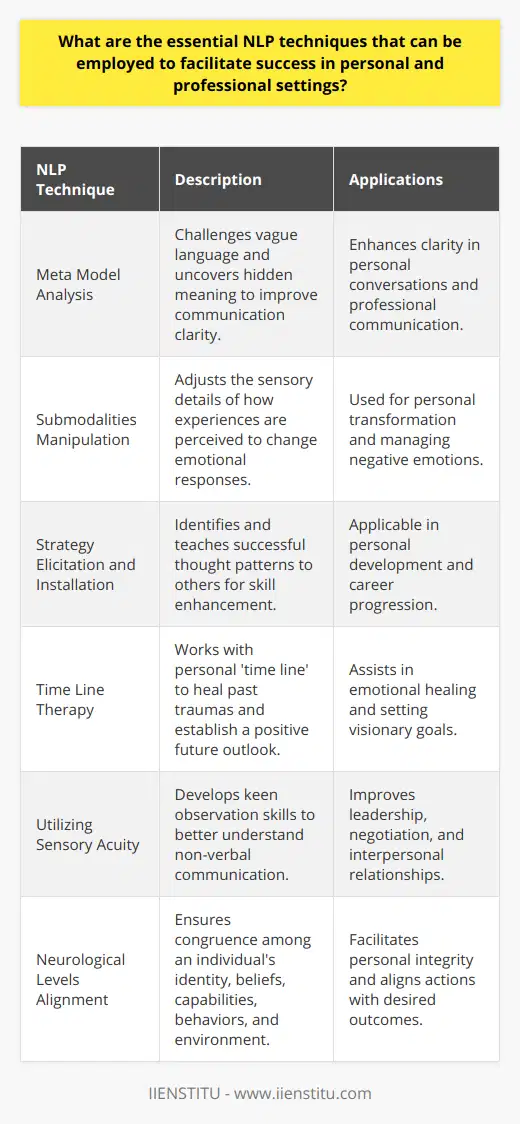
In what ways do the five NLP insights for successful meetings contribute to more effective group discussions and decision-making processes?
Enhancing Group Communication
The five NLP insights for successful meetings can substantially improve group discussions and decision-making processes in various ways. By employing these insights, professionals can elevate communication, encourage collaboration, and eventually achieve their team objectives more efficiently.
Building Rapport
Firstly, establishing a strong rapport with meeting participants helps to create a positive environment, conducive to open communication and idea exchange. Through rapport-building exercises, individuals feel more connected and receptive, promoting understanding and team cohesion. This ultimately leads to more productive discussions and decisions.
Setting Intentions and Outcomes
Secondly, clearly stating intentions and desired outcomes at the onset steers the conversation in a goal-oriented direction. This process ensures that participants are aligned and focused on common objectives, streamlining the decision-making process and minimizing diversions or unnecessary discussions.
Engaging the Unconscious Mind
Thirdly, engaging the unconscious mind by employing positive questioning techniques and reframing issues fosters a more inclusive and creative environment for problem-solving. When team members feel encouraged to think freely and imaginatively, they are more likely to contribute innovative solutions or ideas, boosting the overall quality of discussion and decision-making.
Leveraging Persuasion Techniques
Fourthly, the use of effective persuasion techniques facilitates the negotiation and influence of group members, which can expedite the decision-making process. Through employing different communication styles and building empathy, individuals can convey their opinions in a more convincing manner to gain support or consensus.
Eliciting Feedback and Evaluation
Finally, garnering feedback and evaluating the performance of a meeting allows participants to learn from their experiences and address any area needing improvement. This iterative process of reflection and refinement helps create more effective meetings in the future and enhances the overall efficiency of group discussions and decision-making.
In conclusion, applying the five NLP insights for successful meetings paves the way for more effective group discussions and decision-making processes. By establishing rapport, setting intentions, engaging the unconscious mind, using persuasion techniques, and evaluating performance, participants can ultimately achieve optimal collaboration, creativity, and productivity in their meetings.
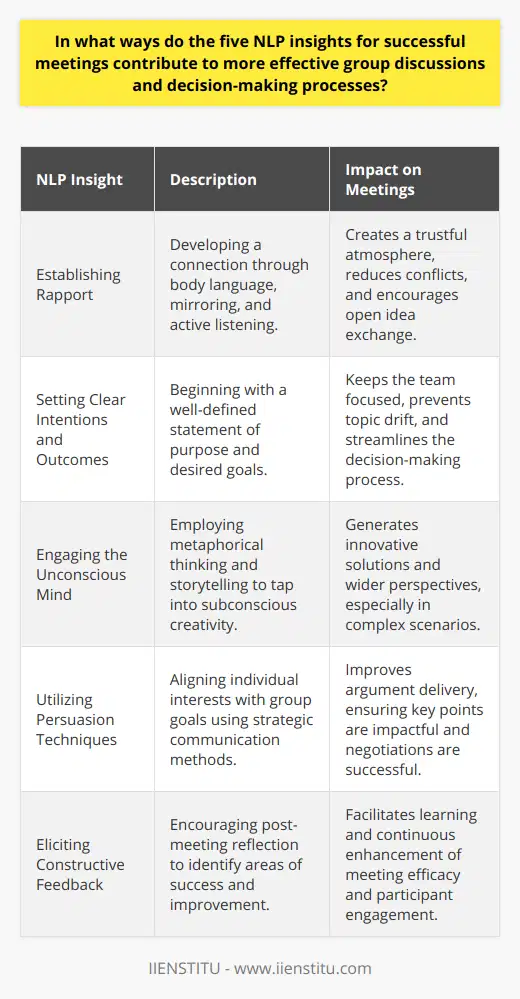
How can the application of the five NLP concepts supporting coaching lead to improved self-awareness, goal-setting, and overall personal development?
Enhancing Self-Awareness through NLP Concepts
The application of Neuro-Linguistic Programming (NLP) concepts in coaching can lead to improved self-awareness, goal-setting, and overall personal development. NLP provides a framework for understanding human behavior, communication, and thought processes. By applying these concepts, individuals can develop a more accurate perception of themselves, their strengths, and their areas for improvement.
Effective Communication and Rapport Building
One vital NLP concept in coaching is building rapport and establishing effective communication. Through active listening, empathizing, and matching clients' language patterns, coaches can create an environment of understanding and trust. This rapport allows individuals to feel comfortable sharing their thoughts and experiences, which leads to better self-awareness and personal growth.
Reframing Limiting Beliefs
Another important aspect of NLP is the ability to reframe limiting beliefs. Coaches can help clients identify beliefs that hinder personal development and guide them in reinterpreting these beliefs in a more positive and empowering way. By changing the way individuals perceive their obstacles, they can develop a growth mindset and set more ambitious goals for themselves.
Utilizing Anchoring Techniques
NLP anchoring techniques offer a powerful tool to associate specific events or emotions with desired states of mind. Coaches can assist clients in creating positive mental anchors, enabling them to access their desired states of motivation, confidence, or relaxation whenever necessary. These anchors support goal-setting and personal development efforts by making it easier for individuals to tap into their inner resources when needed.
Developing Well-Formed Outcomes
In NLP, well-formed outcomes promote clear and specific goal-setting. To create well-formed outcomes, individuals must identify their desired goals, the sensory evidence of achieving them, the resources required, and the possible consequences or impact. Coaches can guide clients in developing well-formed outcomes, ensuring their goals are attainable and aligned with their values, leading to increased motivation and personal growth.
Implementing the TOTE Model
The Test-Operate-Test-Exit (TOTE) model in NLP helps individuals refine their strategies for achieving personal development goals. The model promotes a process of continuous feedback, adjustment, and improvement. By applying this approach, coaches can support clients in continually evaluating their progress toward their goals, adjusting their strategies as needed, and ultimately achieving personal development success.
In conclusion, the application of the five NLP concepts in coaching can lead to significant improvements in self-awareness, goal-setting, and personal development. Through effective communication, reframing limiting beliefs, utilizing anchoring techniques, developing well-formed outcomes, and implementing the TOTE model, coaches can empower clients to realize their full potential and overcome any barriers that hinder their growth.
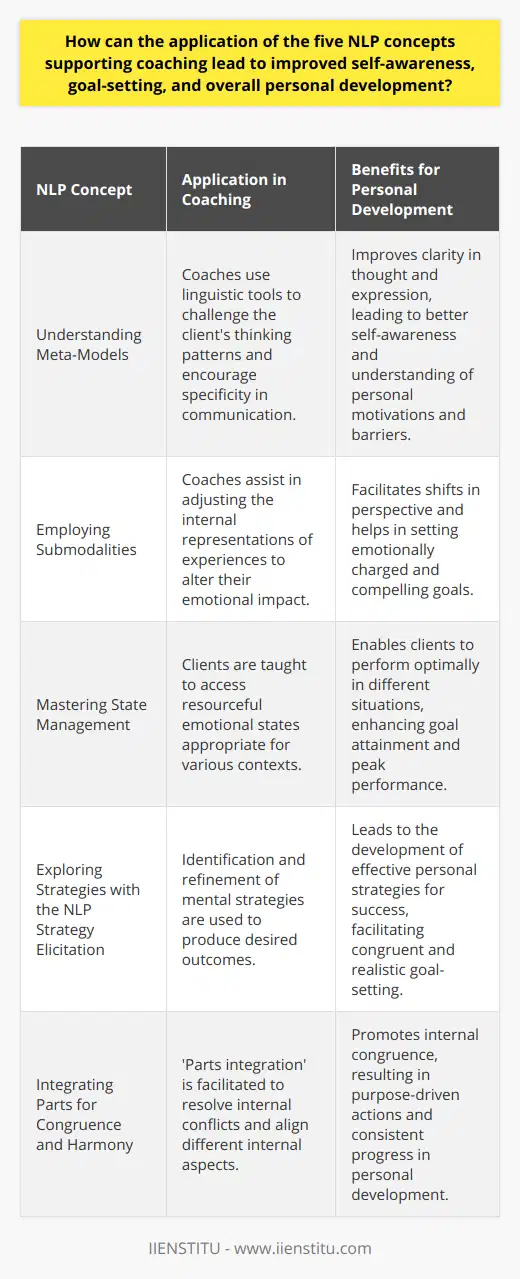
What are the 3 pillars of NLP and how do they shape the overall development of effective communication and personal growth?
**The Three Pillars of NLP**
Neuro-Linguistic Programming (NLP) is an approach to personal development, communication, and psychotherapy that aims to improve an individual's understanding of their cognitive and interpersonal processes. The three pillars of NLP – rapport, outcome orientation, and sensory acuity – play an essential role in developing effective communication and promoting personal growth.
**Establishing Rapport**
The first pillar, rapport, refers to building and maintaining strong connections with others. In NLP, establishing rapport is crucial for effective communication as it helps create a comfortable environment where individuals can openly express their thoughts and emotions. By mirroring and matching body language, tone of voice, and language patterns, NLP practitioners develop trust and understanding with their interlocutors, paving the way for meaningful exchanges and fostering empathy.
**Outcome Orientation**
The second pillar, outcome orientation, emphasizes the importance of setting clear and specific goals as a foundation for personal growth and effective communication. By defining the desired outcome of a conversation or a personal development plan, NLP practitioners can maintain focus and motivation, ensuring that their actions align with their objectives. This goal-setting process helps individuals identify potential hindrances, develop adequate strategies, and measure their progress, ultimately contributing to their personal growth and improved communication skills.
**Sensory Acuity**
Lastly, sensory acuity represents the third pillar of NLP. It involves the heightened awareness of one's surroundings, enabling better perception of verbal and non-verbal communication cues. Sensory acuity allows practitioners to observe and interpret subtle signals, adjust their approaches depending on their interlocutor's reactions, and tailor their communication strategies accordingly. By honing their sensory acuity, individuals can enhance their relational and cognitive empathy, promoting a deeper understanding of others' perspectives and emotional states.
In conclusion, the three pillars of NLP – rapport, outcome orientation, and sensory acuity – are essential components for developing effective communication and fostering personal growth. By cultivating these skills, individuals can strengthen their interpersonal relationships, set clear goals for their development, and enhance their understanding of others' emotions and perspectives. As a result, NLP provides a comprehensive framework that supports individuals in their pursuit of improved communication and personal growth.
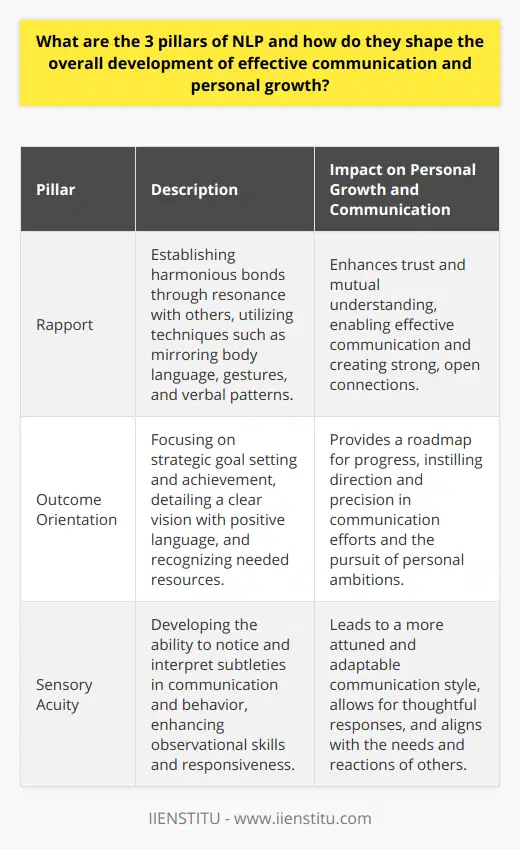
In what ways can NLP techniques for decision making enhance individual and organizational abilities to navigate complex problem-solving situations?
NLP's Impact on Decision Making
One significant aspect of Natural Language Processing (NLP) techniques for decision making is the enhancement of individuals and organizations' problem-solving abilities in complex situations. With NLP, one can better understand, analyze, and interpret complex text data, leading to improved decision making.
Data-driven Insights
NLP enables the extraction of meaningful information from vast amounts of unstructured data, enhancing the decision-making process by providing data-driven insights. For instance, sentiment analysis can identify trends and opinions, thus providing valuable input for decision making in marketing or product development.
Text Classification
Through the use of text classification techniques, NLP sorts and categorizes complex textual information into predefined groups. This helps organizations make sense of large volumes of data, streamlining and prioritizing their efforts in addressing various concerns and tasks.
Information Retrieval
NLP-driven information retrieval enhances decision making by making it easier to locate information in large and diverse data sets. Search engines, for example, rely on NLP techniques to provide relevant search results, enabling users to find valuable information faster and with higher accuracy.
Summarization Techniques
By employing summarization techniques, NLP condenses lengthy and complex documents into concise summaries, providing decision-makers with the essential information and enabling them to quickly grasp the core points. This facilitates more informed decisions without overwhelming them with excessive information.
Automated Decision Support
Finally, the integration of NLP techniques in decision support systems (DSS) enables the automation of certain decision-making processes by interpreting and analyzing text-based data. Such systems can help filter and rank possible solutions according to various criteria, providing users with actionable recommendations.
In conclusion, NLP techniques for decision making hold immense potential in enhancing individual and organizational abilities to navigate complex problem-solving situations. By facilitating data-driven insights, information retrieval, text classification, summarization, and automated decision support, NLP revolutionizes the way we approach decision making in various domains.
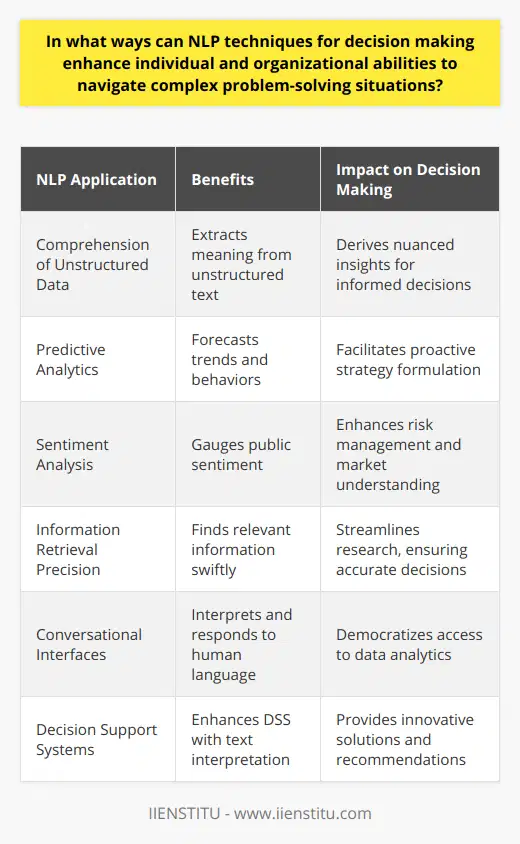
Which NLP technique is considered the best for fostering behavioral change, enhancing self-awareness, and supporting personal and professional development?
The Transformative Power of Neuro-Linguistic Programming
NLP Technique for Behavioral Change
Among the various Neuro-Linguistic Programming (NLP) techniques, the best NLP technique for fostering behavioral change, enhancing self-awareness, and supporting personal and professional development is considered to be the Six-Step Reframing technique. This technique helps individuals in analyzing and reframing their thought patterns and actions that may prove to be limiting in their personal and professional lives.
Efficacy of Six-Step Reframing
The Six-Step Reframing technique is a powerful tool for personal growth as it effectively tackles the challenge of reconciling and integrating conflicting beliefs, values, and behaviors that often hinder individuals' progress in different aspects of their lives. By offering a systematic and structured approach to reframing, it allows individuals to gain more control over their thoughts and actions and brings about desirable changes in their behavior.
Application in Personal Development
The Six-Step Reframing technique has found widespread acceptance and application in various personal development domains, including but not limited to enhancing self-awareness, improving interpersonal relationships, strengthening communication skills, and goal setting. It equips individuals with the necessary tools to modify and update their mental maps and adopt more flexible and adaptive behavioral patterns.
Enhancing Professional Performance
In the professional sphere, the Six-Step Reframing technique can be employed to improve decision-making capabilities, boost problem-solving skills, and promote creativity and innovation. Furthermore, it aids professionals in overcoming psychological barriers such as fear of failure, imposter syndrome, and procrastination, which can significantly impede their learning, growth, and evolution in their careers.
Conclusion
In conclusion, the Six-Step Reframing technique's effectiveness in fostering behavioral change, enhancing self-awareness, and supporting personal and professional development makes it the most suitable NLP technique out of the various available options. Its versatility enables individuals to comprehensively analyze and address cognitive and behavioral limitations, resulting in tangible improvements across various domains of life.
